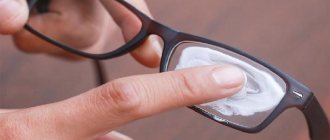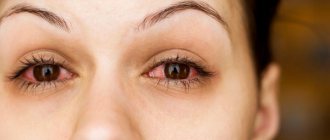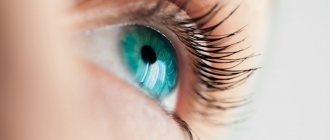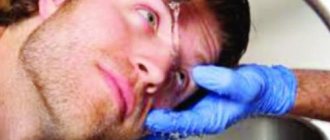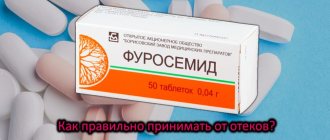Contact lens solution is a special product designed for the care of optical products, namely their cleaning, disinfection and storage. Many people wonder whether it is possible to drop this liquid into the eyes to moisturize, clear away small debris and relieve irritation. We will learn about this in this article.
Lens solution is a liquid with a special composition, including preservatives, active substances and other components. It is used to disinfect products from microorganisms, bacteria, proteins, as well as microparticles of pollutants that appear during wear, day or night.
As a rule, a special container is used to care for lenses, which is filled with disinfectant liquid. Before immersing in this container, the product should be placed on a dry palm and additionally rinsed with the solution on both sides. After this, they should be stored in a container for a long time, and then they can be reused.
How to choose a solution for contact lenses?
Lens solution is a special liquid necessary for processing ophthalmic products, cleaning them from various deposits, and disinfecting them. There is no need to care for daily lenses; they are thrown away immediately after removal. It is necessary to clean and disinfect contact lenses that are used more than once: biweekly, monthly, quarterly, traditional lenses. With the help of solutions, microorganisms that can cause an infectious ophthalmological disease are prevented from entering the cornea. You cannot rinse your lenses with regular running water. Firstly, there may be bacteria in it. Secondly, water cannot destroy germs. In this regard, special liquids are used. There are several types of them. Which lens solution is right for you?
Solution for colored lenses: which one is better to choose?
What is the best lens solution? The choice of contact optics care products today is huge. This can make it difficult to purchase the right product from an inexperienced person. The doctor usually recommends a specific manufacturer or a cleaning liquid with a specific composition. You will have to choose the brand of solution yourself. The most important thing is that it matches your ophthalmic products and does not irritate your eyes. Let us briefly consider the most popular solutions that are in demand among buyers and recommended by experts.
ReNu Multi-Purpose Solution is a multi-purpose solution. It is produced by Bausch + Lomb. Some people's eyes are hypersensitive to various solutions and their individual components. This product does not contain preservatives. The liquid does not cause allergies or irritation. ReNu Multi-Purpose Solution can completely clean and disinfect contact lenses in 4 hours. The solution also additionally moisturizes it.
Biotrue is another popular multi-purpose and versatile solution from Bausch + Lomb. The pH value of the cleaning fluid is identical to the pH of human tear fluid. This means that it is biocompatible and suitable for everyone. In addition, Biotrue contains a hyaluronan component, thanks to which the lenses do not dry out and become even more comfortable.
Opti-Free Pure Moist is a development of the American company Alcon. The solution includes the moisturizing agent HydraGlyde Moisture Matrix. After treatment with this liquid, lenses remain maximally moisturized for at least 16 hours. Opti-Free Pure Moist is a multi-stage disinfection system. Germs and bacteria are destroyed at every stage of processing of ophthalmic products. They remain fresh, clean and hydrated throughout the day.
Comfort Vue is a multifunctional solution from Sauflon (UK). When creating it, the Sterisoft component is used. It helps to moisturize contact optics. This prevents it from drying out and causing discomfort in the eyes. Using Comfort Vue is very convenient, since there is no need to mechanically process the lenses. It is enough to leave ophthalmic products in the solution for 4 hours. During this time, complete cleaning and disinfection occurs.
Maxima Elite is a multifunctional solution produced by Maxima from the UK. It contains the moisturizing agent Aqua Shield and the RemoPro 1 component, which ensures the binding of water molecules. In other words, the liquid simultaneously moisturizes and lubricates the surface of the contact optics, making it comfortable and safe to wear.
Pro Active is a universal type solution manufactured by Optimed. This product includes sodium hyaluronate and cellulose ether. In this regard, it is suitable for people with hypersensitive membranes. The composition also contains succinic acid, which has antioxidant and antihypoxic properties. This prevents the development of hypoxia and corneal clouding.
You can buy a good solution for colored lenses in our online store. In the catalog you will find the presented and other products of the most famous brands.
Which lens solution to choose: types of cleaning liquids
There are 5 types of solutions:
- Water-salt. These are the very first solutions, which today have been replaced by other, more effective means. They were used only for storage and cleaning. It was impossible to disinfect ophthalmic products with their help.
- Peroxide. They are based on hydrogen peroxide and are good at destroying germs.
- Enzymatic (enzyme) cleaners are means for deeper cleaning of protein and lipid deposits.
- Multifunctional. They perform several functions: from cleansing to moisturizing.
- Universal. They are suitable for all types of contact optics.
Each of the listed solutions performs specific functions and is intended for certain lenses. Let's take a closer look at each type of cleanser, except water-salt, which is not used today.
Features of peroxide cleaning systems
Peroxide cleaning systems are based on hydrogen peroxide (H2O2), the most famous antiseptic. This means that the main task of a peroxide cleaner is to disinfect the surface of contact optics. Hydrogen peroxide destroys all types of bacteria, microbes, fungi, and viruses. At the same time, there are no preservatives that could provoke an allergic reaction in peroxide systems. Therefore, they are suitable for people with very sensitive eyes.
There are two types of peroxide cleaners: one-step and two-step. In the first case, a container with a catalytic platinum disk is used for cleaning. The lenses are placed in it for 6 hours and disinfected. After this, ophthalmic products do not need to be rinsed, since the peroxide itself is neutralized in the platinum disk. In a two-stage treatment, after disinfection and storage, lenses must be washed in a different solution that does not include H2O2. To do this, you can use regular saline solution or other rinsing and washing liquids.
Peroxide systems are recommended for people who wear quarterly and traditional lenses. They are not suitable for processing contact optics with decorative functions, as they can lead to destruction and leaching of the coloring pigment. Peroxide-based products also have other disadvantages. They can damage contact optics with a high level of moisture content when stored in solution for a long time. Peroxide systems are also inconvenient to use while traveling or for quickly cleaning contact optics. It is completely disinfected for at least 6 hours. There are other drugs that help cleanse in a shorter period of time.
Why can’t a regular solution be dripped into the eyes?
Many people wonder whether it is possible to drop this liquid into the eyes if dryness occurs? Ophthalmologists give a clear answer that this should not be done:
- these products have a concentrated composition, which in large dosages can cause irritation of the mucous membrane and even burn the cornea;
- liquid will not eliminate dryness, but will only worsen it;
- the solution will not replace eye drops, which are designed to eliminate redness, remove debris and relieve tension, and will only make it worse.
After you remove the products from the container and put them on, a small amount of liquid enters the eye, which does not have a negative effect. However, if you are individually intolerant to the components included in its composition, redness, itching, burning and stinging may occur. In this case, it is necessary to accurately determine the cause of the allergy and eliminate it.
Which peroxide type product should I choose? The most popular are:
- One Step is the first contender for the title of "Best Contact Lens Solution" in a series of peroxide systems. It is produced by Sauflon. The solution comes with a container with a platinum disc, so you can perform a one-step cleaning without additional rinsing.
- Aosept Plus from Alcon. It is part of a series of drugs labeled No Rub. This means that mechanical cleaning of the contact optics with your fingertips is not required.
- Ever Clean by Avizor. This lens solution always comes with a container equipped with a platinum disc.
How to properly care for colored lenses?
The process of caring for decorative contact optics is no different from caring for conventional contact correction products. When purchasing a solution, pay attention to the cleaning method.
No Rub System solutions eliminate the need to clean lenses by hand. Ophthalmic products clean themselves while they are in the liquid container. When using liquids without a No Rub system, contact optics must be wiped with your fingertips. Before starting the care procedure, wash your hands thoroughly. Containers must be washed and disinfected in the same way as lenses. In addition, containers for storing contact optics should be changed every 2-3 months. As a rule, manufacturers sell solutions complete with a container.
Enzyme cleaners for contact lenses
Enzymatic or enzymatic agents are necessary for deep cleaning of deposits. Available in tablets. They must be used in conjunction with multifunctional or peroxide products. The tablets are dissolved in the cleaning liquid, after which the lenses are placed in it for 10-15 minutes. After this, they are washed in a fresh solution. Enzyme treatment should be carried out every 7-10 days.
The most popular drug of this type is Enzyme tablets from the Spanish company Avizor. The main component of the cleaner is Subtilisin A. It helps remove deep protein deposits and is low toxic. Enzyme tablets dissolve quickly in any solution.
Multifunctional lens solutions
Multifunctional products are the most popular today. They perform several functions at once: cleaning, rinsing, disinfection, moisturizing. Additionally, multi-purpose cleansers are used to store ophthalmic products. Almost all companies that produce contact products produce such products: Alcon, Bausch + Lomb, Sauflon and others.
How to choose the right lens solution?
So, now you know what cleaning liquids exist. Next, you need to decide which type of solution to choose. It all depends on what correction tools you use. It is better to select a solution for colored contact lenses from the line of multifunctional and universal cleaners. They do not contain hydrogen peroxide, which can harm the coloring properties of decorative contact optics. Almost everyone will have to purchase enzyme tablets. An exception can be made only for lenses designed to last for two weeks. For one-day plants, no solution is required at all.
It is recommended to choose a solution for silicone hydrogel contact lenses from the range of new products. Ophthalmic products made from silicone hydrogel are the newest. Many popular cleaners were created specifically for hydrogel materials before the advent of silicone hydrogel. Modern preparations are suitable for hydrogel and silicone hydrogel lenses.
Before purchasing a solution, consult an ophthalmologist. The cleanser must be suitable for certain physiological parameters, including corneal sensitivity. It is best to purchase cleaning products from the manufacturer whose lenses you wear. However, this criterion is not mandatory. Modern multifunctional and universal solutions are suitable for any type of optics. For your convenience, we will compile a rating of the best solutions based on their demand among customers of our online store.
Comparative lens characteristics
Having studied all the technical characteristics of materials and the operating features of optical products, you can begin to compare them. Particular attention should be paid to the following parameters:
- comfortable wearing and initial lens insertion. The latest generation hydrogel models (Proclear or Biotrue 1-day) contain 60% moisture, so their advantage here is obvious;
- safe operation. As for safety, silicone hydrogel models are the leaders here, the use of which does not lead to corneal hypoxia;
- resistance to lipid and protein deposition. In this category, both hydrogel and silicone hydrogel products win, but only for one-day wear.
Silicone hydrogel lenses are denser, so even a beginner does not experience any discomfort when putting them on. And hydrogel ones are somewhat cheaper, which often becomes the determining factor when choosing. Moscow contact lenses are sold in many pharmacies, including ours.




